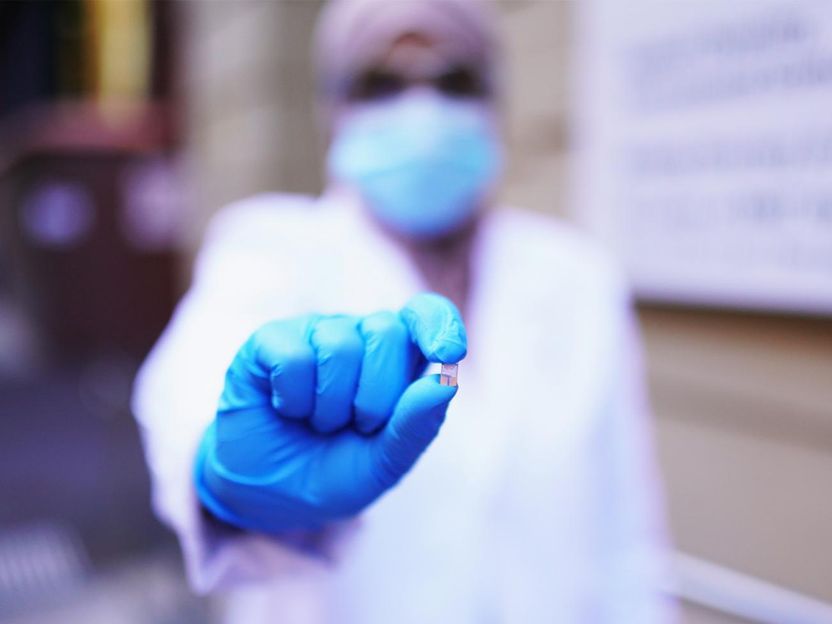Argonne scientists prove unconventional superconductivityin new iron arsenide compounds
Inelastic neutron scattering is sensitive to sign of superconducting gap
Scientists at U.S. Department of Energy's Argonne National Laboratory used inelastic neutron scattering to show that superconductivity in a new family of iron arsenide superconductors cannot be explained by conventional theories.
"The normal techniques for revealing unconventional superconductivity don't work with these compounds," physicist Ray Osborn said. "Inelastic neutron scattering is so far the only technique that does."
Conventional superconductivity can be explained by a theory developed by Bardeen, Cooper, and Schrieffer (BCS) in 1957. In BCS theory, electrons in a superconductor combine to form pairs, called Cooper pairs, which are able to move through the crystal lattice without resistance when an electric voltage is applied. Even when the voltage is removed, the current continues to flow indefinitely, the most remarkable property of superconductivity, and one that explains the keen interest in their technological potential.
Normally, electrons repel each other because of their similar charge, but, in superconductors, they coordinate with vibrations of the crystal lattice to overcome this repulsion. However, in the iron arsenides, scientists don't believe the vibrational mechanism is strong enough to make them superconducting. This has led theorists to propose that the superconductivity has an unconventional mechanism, perhaps like high temperature copper oxide superconductors. Some iron arsenides are antiferromagnetic, rather than superconducting, so magnetism rather than atomic vibrations might provide the electron glue.
In BCS superconductors, the energy gap between the superconducting and normal electronic states is constant, but in unconventional superconductors the gap varies with the direction the electrons are moving. In some directions, the gap may be zero. The puzzle is the gap does not seem to vary with direction in the iron arsenides. However, theorists have argued in these new compounds, while the size of the gap shows no directional dependence, the sign of the gap is opposite for different electronic states. The standard techniques to measure the gap, such as photoemission, are not sensitive to this change in sign. But inelastic neutron scattering is sensitive. Osborn, along with Argonne physicist Stephan Rosenkranz, led an international collaboration to perform neutron experiments at the ISIS Pulsed Neutron and Muon Source in Great Britain using samples of the new compounds made in Argonne's Materials Science Division, and discovered a magnetic excitation in the superconducting state that can only exist if the energy gap changes sign from one electron orbital to another.
"Our results suggest that the mechanism that makes electrons pair together could be provided by antiferromagnetic fluctuations rather than lattice vibrations," Rosenkranz said. "It certainly gives direct evidence that the superconductivity is unconventional."
Original publication: Nature, Volume 456, pages 930-932.
Most read news
Topics
Organizations
Other news from the department science

Get the analytics and lab tech industry in your inbox
By submitting this form you agree that LUMITOS AG will send you the newsletter(s) selected above by email. Your data will not be passed on to third parties. Your data will be stored and processed in accordance with our data protection regulations. LUMITOS may contact you by email for the purpose of advertising or market and opinion surveys. You can revoke your consent at any time without giving reasons to LUMITOS AG, Ernst-Augustin-Str. 2, 12489 Berlin, Germany or by e-mail at revoke@lumitos.com with effect for the future. In addition, each email contains a link to unsubscribe from the corresponding newsletter.
Most read news
More news from our other portals
Last viewed contents
Link Technologies secures exclusive license for ultra sensitive diagnostic probes - Deal marks the start of ongoing collaboration between Link and The University of Manchester
Odorant shape and vibration likely lead to olfaction satisfaction

In the beginning was the phase separation - Was a simple mechanism decisive for the origin of life?

New butterfly-inspired hydrogen sensor is powered by light - Light-activated sensor delivers precision results at room temperature: For medical applications and hydrogen economy




















































